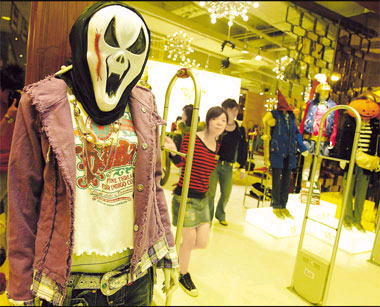|

|
|
With the Halloween around, skull and skeleton-themed outfits are extremely popular among young people. [Shanghai Daily] |
A grinning skull and crossbones, once a morbid emblem of the goth counterculture, pirates and paleontologists, have become today's "smiley face."
The symbol of death, danger, poison and toxic waste - a reminder that all vanity turns to dust - has moved from the shades of questionable taste to the glittery fashion mainstream.
Skulls with gaping eye sockets and grim smile can be found on virtually anything nowadays - dresses, jackets, T-shirts, jewelry, handbags, scarves and so on.
While older generations might have a few reservations about decking themselves out in death's heads and regard it bad luck, young people in China dismiss that old-fashioned message. "It's so cool" is young people's response, if they ponder it at all.
"I've seen many Hollywood celebrities wearing skull scarves in the magazines or on the Internet," says shop owner "luxuryskymall" on Taobao.com, China's most popular online shopping site. "They all look super cool."
Her shop sells skull scarves of various colors and styles, priced between 48 yuan (US$7) and 220 yuan. The bestseller, a simple black-and-white skull scarf made of silk, priced at 99 yuan, more than 1,000 have been sold in three months.
According to "luxuryskymall," as Halloween is around, it's normal to sell 50 to 60 scarves in one day. "Anything with skull prints is popular these days," she says. "T-shirts, jeans, bags and shoes with skull and crossbones sell quickly on Taobao."
Liu Xiao, a 30-year-old Shanghai lady, bought a skull-bedecked hoodie last year in a boutique. "I like it very much," she says. "The cute, crystal-paved skull print on the back makes the otherwise basic streetwear style very chic and unique."
When asked what their parents think of her fashion statement, she says: "Who cares?"
Lin Qing, 55, has seen her daughter wearing a watch with a skull pattern. "I suppose it's fashionable with young people," she says. "I think it looks fine, as long as she likes it."
But not everyone finds the skull fashion drop-dead gorgeous.
"Some of my schoolmates wear T-shirts or caps with skull and crossbones and feel good about themselves," says college student Jenny Zhang, 20. "But to me, they just look stupid."
Still, she once was tempted to try on a skull scarf, only to be told by her boyfriend it was ugly. "He thinks girls should not wear skulls, which is not feminine at all," she adds.
The skull fashion goes back two years, when famous English designer Alexander McQueen created an exquisite scarf covered with skulls. Followed by designers like Thomas Wylde and Tiffany Alanas, the design soon became a fashion statement that had been tied, knotted, or slung over many Hollywood celebrities like Sienna Miller, Lindsay Lohan, Ashley Olesen, Nicole Richie and even the ladylike starlet Mischa Barton.
"Skull fashion isn't just a fad," says J. Huang, a visual merchandiser at US fashion chain Forever 21, calling himself a "fashionista." "It has always been a phenomenon among streetwear fashion lovers both in the US and Japan."
It isn't all about that "cheap and chic" stuff that people find in small stores along the streets either, he adds. Some skull-and-crossbones fashion can be unbelievably expensive.
For example, one of Huang's favorite brands, Mastermind, is a high-end menswear label from Japan targeting the well-heeled fashion customers. All products are made in limited quantity, emblazoned with the Mastermind Japan skull-and-crossbones logo.
They use super luxe materials such as sea island cotton and feature a simple palette of black and white. A plain Mastermind T-shirt has been sold for as much as 10,000 yuan in an Internet auction.
"Many people might think it is ridiculous to spend that much money on a T-shirt," says Huang, "but a quality T-shirt like that can be worn over the years. It never goes out of fashion."
A more affordable alternative is Cheap Monday, a Swedish denim manufacturer known for its skull logo with an upside-down cross. The brand's stylish jeans are sought all over the world for their classic high waist, tapered legs and reasonable price.
However, when it first hit the scene in 2004, Cheap Monday generated controversy over its logo use of an inverted cross on the skull's forehead.
Many outlets have banned sale of articles bearing the logo, citing an unacceptable "anti-establishment vibe."
Bjorn Atldax, designer of the logo, once told The Associated Press that it was an active statement against religion. "I'm not a Satanist myself, but I have a great dislike for organized religion," he said.
The designer said young consumers should consider the message that wars and death have been caused by religious intolerance and extremism.
Anyhow, it's easy to look drop-dead gorgeous for Halloween, or any time.
(Shanghai Daily October 31, 2008)